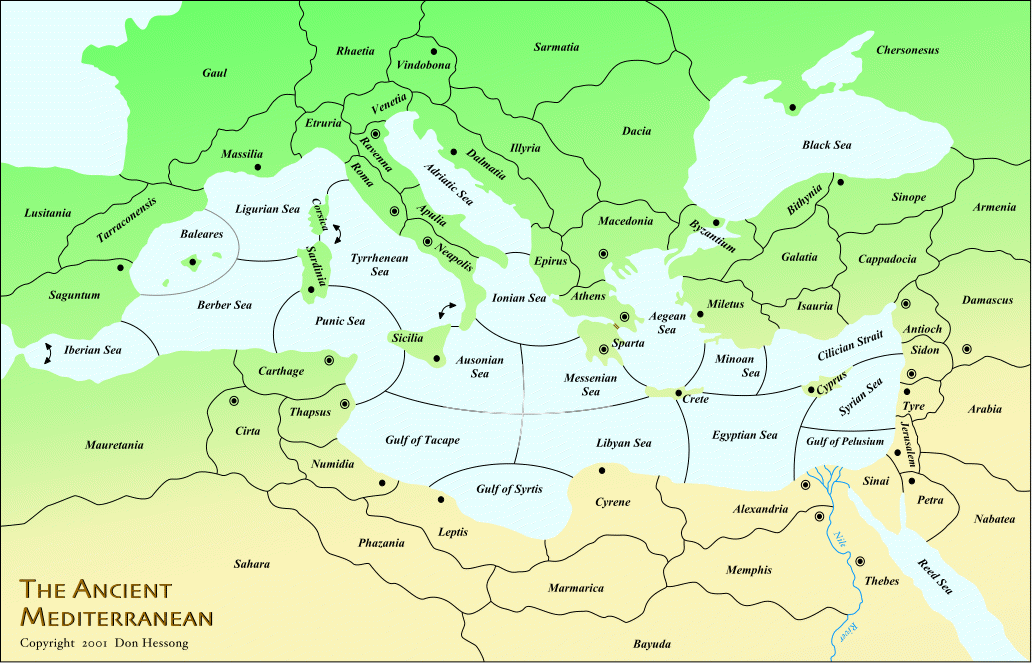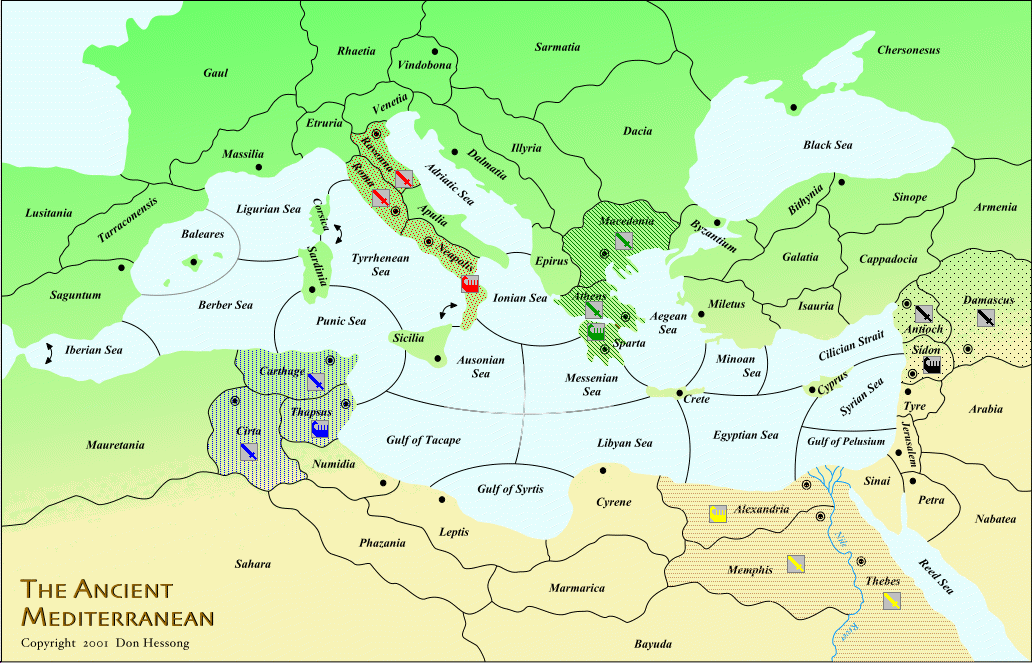Ancient Mediterranean
Created by: Don Hessong
Variant Description:
The normal rules of the game of Diplomacy apply, with the following additions, exceptions and clarifications. Note there is only one minor exception to the normal rules (Baleares). The rest of the following explanations involve either the expected things that must be defined in Diplomacy variants or geographical considerations which simply clarify where units may or may not move. If you are familiar with the normal rules of Diplomacy, you will be able to read through the following very quickly - it's not as long as it looks.
Ancient Med Openings Article Ancient Med Strategy Article
Home Supply Centers And Starting Positions Of The Powers:
Rome (red)
•fleet Neapolis
•army Roma
•army Ravenna
Carthage (dark blue)
•fleet Thapsus
•army Cirta
•army Carthage
Greece (green)
•fleet Sparta
•army Athens
•army Macedonia
Persia (black)
•fleet Sidon
•army Antioch
•army Damascus
Egypt (yellow)
•fleet Alexandria
•army Memphis
•army Thebes
Note that on the map, home supply centers are designated by a dot with a circle around it, whereas supply centers which start the game unowned, are designated by a plain dot. As in the normal rules, a power may build new units only in its home supply centers.
Game Notes:
Victory Criteria
18 supply centers. This is a simple majority (it's just coincidence that Ancient Med has the same number of supply centers as the standard game).
Move Dates And Adjustments
Each turn alternates between Spring and Fall, starting the game on a Spring turn, with adjustments being made after a Fall turn. Each successive Spring the year increases by one. This is just like the standard game except the variant’s first year is 01 AD instead of 1901 AD.
Impassable Spaces
Any areas that are not named on the board are not passable. The Atlantic Ocean can not be occupied by any units.
Islands
Islands are distinct spaces. An island may be occupied by an army or a fleet. Each island has one continuous coast, therefore a fleet on an island may move to any space adjacent to it. For example, a fleet could move from the Egyptian Sea to Crete in one turn, and then move to the Aegean Sea in the next turn.
Movement Across Narrow Straits
Arrows on the board indicate two adjacent land (coastal) spaces. An army may move from one space to the other in one turn without being convoyed. Because they are adjacent, fleets may also move from one space to the other in one turn. Note that the Tyrrhenean Sea is adjacent to the Ausonian Sea.
Byzantium
Byzantium is one space which straddles a waterway. The waterway allows movement of a fleet in Byzantium to any adjacent coastal space or sea space. The waterway does not impede the movement of an army through Byzantium. And it is a supply center. In other words, it works just like Constantinople in the standard game.
Baleares
Baleares is a single space (which consists of the islands and the water around them). Since it contains both land and water, it can be occupied by a fleet or an army. However, since it is a single space, it can only be occupied by one unit at a time. Although an army can occupy Baleares, it can not move there directly from the mainland spaces since the islands are too far from the coast. For an army to enter or leave Baleares, it would have to be convoyed by a fleet in the Berber Sea or the Ligurian Sea. Since Baleares consists mostly of water, it is considered a sea space for the purposes of convoys, therefore a fleet occupying Baleares may be used to convoy an army using the normal convoy rules. Baleares is a supply center.
Four-way Intersection in the High Seas
In the middle of the board there is an area where four sea spaces come together at one point. They are the Ausonian Sea, Messenian Sea, Gulf of Tacape and Libyan Sea. All four of these spaces are adjacent to each of the other three at that point. Therefore, a fleet in one of these spaces may move to any of the other three. In other words, a fleet in any of these spaces may move diagonally.
By virtue of the expanse of the open seas, fleets can pass each other in a criss-cross fashion without impeding each others' movement. For example, a Roman fleet could move from the Ausonian Sea to the Libyan Sea and a Greek fleet could move from the Messenian Sea to the Gulf of Tacape on the same turn and both of these moves would be allowed. Note that this criss-crossing is not the same as two units exchanging places. For example, if a Roman fleet tried to move from the Ausonian Sea to the Libyan Sea and an Egyptian fleet tried to move from the Libyan Sea to the Ausonian Sea on the same turn, these moves would not be allowed due to the normal rules.
The Diolkos
The border between Sparta and Athens effectively works like a canal. It cuts across the isthmus and allows fleets to move through. For example, a fleet in the Aegean Sea could move to Athens and then, on the following turn, to the Ionian Sea. Note that in game terms, this means Athens effectively has one continuous coast. Armies can freely move between Sparta and Athens.
The historical precedence for this is not an actual canal. The Diolkos was a roadway built by the Greeks for the purpose of moving ships across the isthmus on large wheeled carts. You can still see the ruts in the ground today. See Ancient Diolkos of Corinth and The Diolkos and the Corinth Canal.
The Nile River and Canal
The Nile River acts as the boundary between the spaces on its east and west banks. The river is not a space on the board. It can not be occupied by any units. However, it is considered to be navigable. Therefore, a fleet may move to and from spaces that are adjacent along the river. For example, Sinai to Thebes, Thebes to Memphis, Memphis to Alexandria would all be legal moves for a fleet. Memphis to Cyrene would not be a legal move for a fleet. Egypt can build fleets in any of its home supply centers.
There is also a canal that connects the Nile River Delta to the Reed Sea. It acts as the boundary between Sinai and Thebes. It is also navigable and therefore allows fleet movement between Sinai, Thebes and Reed Sea. Reed Sea is not adjacent to the Gulf of Pelusium or Alexandria. Notice that due to the various waterways and coastlines, Sinai and Thebes each have one continuous coast.
Armies can freely move across the Nile River and canal.
There actually is much precedence for a canal connecting the Nile River to Reed Sea in ancient history. It required constant dredging to keep it clear of sand and therefore was subject to long periods in history of not being navigable (although this spuratic availablitly is not reflected in the game). See Pharaonic Egypt: Canals and Ancient Economies (this second article is long and does not deal with the canal directly, so search for the word "canal" using your browser's find command).
The Nile River Delta
The Nile Delta is not a distinct space on the board. It can not be occupied by any units. There are four spaces which are in contact with the delta. They are Alexandria, Thebes, Sinai and the Gulf of Pelusium. All four of these spaces are considered to be adjacent to each of the other three, at all times, by virtue of the multiple water channels in the delta. This provides increased flexibility concerning the movement of fleets. A fleet in any of these four spaces may move to any of the other three. The delta does not impede the movement of armies. An army in any of the three land spaces in contact with the delta, may move to either of the other two.
The key to remember is that Thebes is always adjacent to the Gulf of Pelusium AND Alexandria is always adjacent to Sinai (in addition to the obvious adjacancies). For example, a fleet could move from Thebes to the Gulf of Pelusium and, on the same turn, an army or a fleet, could move from Alexandria to Sinai. It should be noted that this criss-crossing is not the same as two units exchanging places which is not allowed.
Convoy Clarifications
As in the normal rules, no fleet in a land space can convoy armies. This includes any coastal space, island, Byzantium and land spaces adjacent to the Nile River or the delta. Baleares is considered primarily a sea space for the purposes of convoys, therefore a fleet occupying it may be used to convoy an army using the normal convoy rules.
Abbreviations For Ancient Med Names:
For almost every space on the board, the first three letters of the name are used for its abbreviation. This includes spaces which have two words in the name. So the Egyptian Sea is "Egy" and the Cilician Strait is "Cil". None of the letters in the words "sea" or "strait" are used. However, names that have three words in them use the first letter of each of the three words. So the Gulf of Pelusium is "GoP". There are only a few exceptions to these guidelines due to redundancies. The following is a complete list of the exceptions to the "use the first three letters" rule.
•Gulf of Pelusium = GoP
•Gulf of Syrtis = GoS
•Gulf of Tacape = GoT
•Sardinia = Sad
•Sarmatia = Sam
•Sinai = Sii
•Sinope = Sip
•Tyre = Tye
•Tyrrhenean Sea = Tyn

